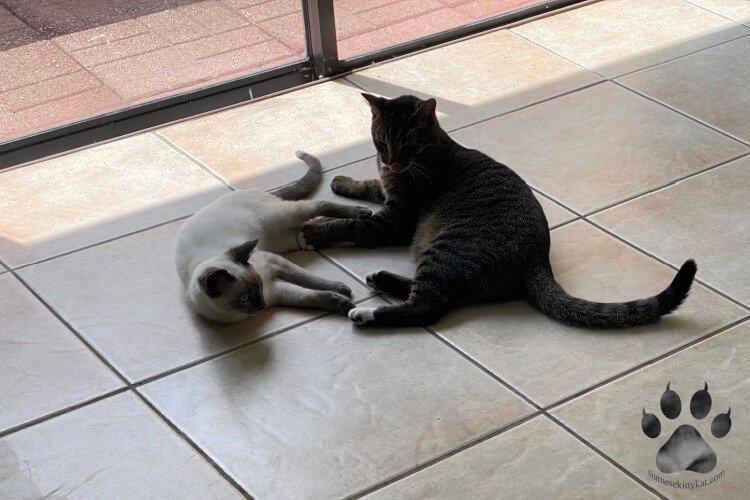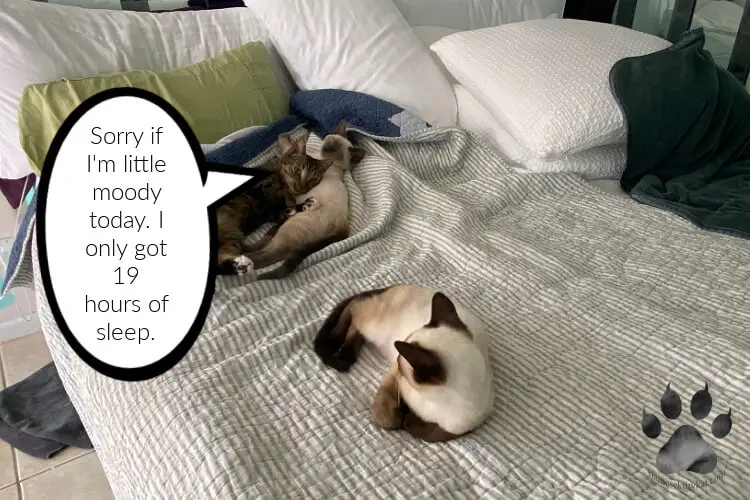Siamese cats are chatty little creatures! These cats are exceptional when it comes to communication. They are incredibly vocal and expressive.
Siamese cats communicate through super distinct meows and body language. They also talk through eye contact. They look right at you with big blue eyes and show you some love when they feel chill and happy. They stare you down with dilated pupils if they feel aggressive and threatened.
They are sassy Siamese, indeed.
Batman and Robyn, my two Siamese cats, have taught me a lot about cat language through their behavior.
I like how I’ve become more attuned to my cats’ behavior. I learned a lot about cat language because of them.
Let me share how Siamese cats communicate and what these signals mean. Keep reading!
How Do Siamese Cats Communicate With Each Other?
Here are the fascinating ways Siamese cats communicate and what they mean:
1. Meows and Vocalizations
Siamese cats are famous for their vocalizations. These vocalizations range from purring and meowing to hissing and growling. Each sound has a different meaning, and cats use them to communicate other things.
Purring is a sign of contentment and relaxation. You can hear this when a cat is being petted or held. Meowing, on the other hand, is a more complex form of communication. Siamese cats meow for many reasons. They meow to get attention, express hunger or thirst, or communicate discomfort or pain.
Hissing and growling are warning sounds when a cat feels threatened or aggressive. They hiss or growl while arching their backs and flattening their ears.
I woke up in the middle of the night by loud, persistent meowing. I stumbled out of bed and headed towards the living room, where Batman and Robyn were waiting for me.
Their vocalizations were louder than ever before. Robyn was pacing back and forth, meowing loudly. Meanwhile, Batman was sitting on the couch, staring intently at me.
I looked around the room, trying to figure out what was causing the commotion. However, I couldn’t see anything unusual. Suddenly, I noticed a mouse darting across the floor. Batman jumped off the couch and chased the mouse.
Robyn continued to meow loudly, probably trying to alert me to the mouse’s presence. I quickly grabbed a broom and helped Batman catch the mouse. He promptly dispatched with a quick swipe of his paw.
I couldn’t help but marvel at the communication skills of my two cats as I cleaned up the mess. They had worked together to catch the mouse. Robyn alerted me with the mouse presence and Batman hunting.
2. Body Language

Siamese cats are masters of body language and use it to communicate in various ways.
Some common body language signals include:
3. Eye contact
Direct eye contact is a sign of aggression in Siamese cats. A relaxed, half-closed gaze, on the other hand, is a sign of contentment.
Direct eye contact with a cat shows aggression or dominance, so avoid staring at them too long. Instead, look at your cat with a relaxed, half-closed gaze. Your cat will know that you’re being friendly and non-threatening. A slow blink indicates that your cat trusts and feels comfortable around you.
4. Tail position
A cat’s tail can communicate a lot about his mood. A raised tail means happiness, while a low or tucked tail means fear or anxiety.
Please pay attention to the position of your cat’s tail to understand how they’re feeling. A raised tail usually means your cat is feeling happy and confident.
However, if your cat’s tail is low or tucked between his legs, it may feel fearful, anxious, or submissive. Your cat’s tail twitching is a sign of excitement or anticipation.
5. Ear position
A cat’s ears can also convey his mood. Forward-facing ears express interest or alertness. Flattened ears signify fear or aggression.
Your cat’s ears can also reveal a lot about his mood.
Siamese cats point their ears forward when they feel alert and wary. They flatten their ears against their head as a sign of fear or aggression. They try to keep track of different sounds and movements in their environment. This is why you’ll often see them constantly twitching and rotating their ears.
6. Posture

A cat’s posture can communicate a lot about his mood. An arched back and raised fur mean fear or aggression. Meanwhile, a relaxed posture means contentment.
A cat’s posture can give clues about his mood. Your cat has an arched back and raised fur because he feels fearful or aggressive. A relaxed posture, on the other hand, means your cat is feeling calm and content. Your cat is ready to pounce or play if he crouches low with their hindquarters raised.
7. Scent Marking
Siamese cats also communicate through scent marking. They have scent glands on various parts of their bodies, including their paws, face, and tail. They leave behind their scent to convey different information. They use scent marking for territorial boundaries, mood, or readiness to mate.
I was lounging on the couch one sunny afternoon when I noticed Batman and Robyn getting restless. They started roaming the room, sniffing every corner and object. I watched as they went to their separate scratching posts. They began to scratch vigorously, leaving their scent behind.
I continued observing. I noticed Batman and Robyn rubbing their cheeks on various objects around the room. They were leaving a subtle but distinct scent mark everywhere they went.
It was fascinating to see my cats’ behavior up close. I knew scent marking was a way for them to communicate with other cats in their territory. It was a way of saying, “I was here, and this is my space.”
They settled near me, purring as they finished scent marking.
8. Visual Cues
Siamese cats communicate through visual cues, including vocalizations, body language, and scent marking. For example, a cat may raise his paw to signal he wants to play. Meanwhile, a cat flicks his tail to show his agitation.
Siamese cats also use visual cues to communicate with humans. For example, a cat may rub against a person’s leg to signal that it wants attention or food.
I was sitting on the floor playing with my two cats, Batman and Robyn, last night. They were both sitting in front of me. They observed as I moved a toy around. Most of the time, they puff out their fur and arch their backs when they feel playful. So I tried to observe if this was the case.
Suddenly, Robyn’s ears perked up, and she stared into the distance. I followed her gaze and saw Batman approaching from the other room. Robyn let out a low growl as Batman entered the room. Batman immediately stopped. He lowered his head and slowly approached Robyn, keeping his eyes on her the whole time.
Robyn’s growling stopped when they got closer. She tilted slightly, indicating she was willing to play with Batman. Batman responded by chirping and jumping up to play with her.
Seeing how much these cats could communicate without making a sound was incredible. I felt grateful to have such intuitive and intelligent pets.
9. Socialization
Siamese cats are social animals. They need interaction with other Siamese cats to thrive. Cats use body language, scent marking, and visual cues to convey their intentions.
Cats sniff each other the first time they meet to exchange scents and understand their moods. They may also play or groom, establishing trust and social bonds.
I introduced our Siamese cats, Batman and Robyn, to our existing cat, Boots. Boots was the alpha cat of the house. We were pretty worried about how they would get along. But to our surprise, Boots welcomed them with open paws.
Batman and Robyn were initially cautious around Boots.
The three cats began to bond and socialize over time. They often played together. They chased each other around the house and curled up together for naps. It was clear they had formed a strong social bond.
I walked into the living room one day and found my three cats lounging together on the couch. Boots was lying in the middle, and Batman and Robyn curled up on each side of him. They were all purring contentedly, enjoying each other’s company.
It was heartwarming to see the three cats socializing and bonding!
Siamese cats are very skilled at using signals to convey their moods and intentions. Try reading these feline signals, and guess what your cat is trying to tell you.
Pay attention to your cat’s vocalizations, body language, scent marking, and visual cues. You can develop a deeper understanding of your furry friend this way.
Siamese cats are incredible communicators. Try spending time observing their behavior too. This will help you better understand their needs and emotions.
I always encourage cat owners to learn more about their cat’s communication signals. Doing so can help us provide them with the best care and attention possible.
Want to learn more about your Siamese cat’s behavior? We have compiled every information you need to navigate through the fascinating world of Siamese cats: Everything About a Siamese Cat’s Behavior: A Comprehensive Guide
Want to immerse yourself more in the captivating world of Siamese cats? I’ve got all the information you need from their distinct color points to their fun personalities: Siamese Cats: Unique Features and Personality
